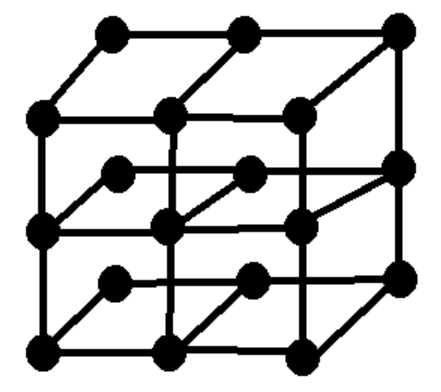
In the spring-ball model of intermolecular forces, the balls represent …………. and springs represent …………….
A. atoms, interatomic forces
B. nuclei, nuclear forces
C. masses, gravitational forces
D. none of the above
Answer
502.5k+ views
Hint: In order to solve this problem you need to know the concept of the spring ball model of intermolecular forces that is in that model the spherical-shaped object at the corner represents mass and that of the lines or springs between two masses represents the interatomic forces between them. Knowing this will solve your problem and will give you the right answer.
Complete answer:
The figure of the spring ball model can be drawn as,

Here the spherical-shaped or ball-shaped object represents the mass of the atom and the spring as denoted here by lines represents the interatomic forces between the atoms.
In a solid, each atom or molecule surrounded by adjacent atoms or molecules. They are bound together by inter-atomic or intermolecular forces and remain in a stable equilibrium position. When the solid is deformed, the atoms or molecules are shifted from their equilibrium positions, creating a change in inter-atomic (or intermolecular) distances.
When deforming forces are withdrawn, the interatomic forces appear to drive them back to their original positions. As a result, the body regains its original shape and scale. The process of restoration can be visualized using the spring-ball device model shown in the figure. Here the balls represent the atoms and the springs represent the inter-atomic powers.
From the above information, it is very clear that springs represent interatomic forces and balls represent masses.
So, the correct option is A.
Note: The figure of this model should be remembered in this mind knowing that balls represent masses and spring represents interatomic forces. Students will see a very similar diagram in the chapter: the solid-state in which cubic cells are drawn like this in those diagrams balls represent ions or atoms or molecules and lines represent the forces between them. Knowing this will help you further and will give you the right answers.
Complete answer:
The figure of the spring ball model can be drawn as,

Here the spherical-shaped or ball-shaped object represents the mass of the atom and the spring as denoted here by lines represents the interatomic forces between the atoms.
In a solid, each atom or molecule surrounded by adjacent atoms or molecules. They are bound together by inter-atomic or intermolecular forces and remain in a stable equilibrium position. When the solid is deformed, the atoms or molecules are shifted from their equilibrium positions, creating a change in inter-atomic (or intermolecular) distances.
When deforming forces are withdrawn, the interatomic forces appear to drive them back to their original positions. As a result, the body regains its original shape and scale. The process of restoration can be visualized using the spring-ball device model shown in the figure. Here the balls represent the atoms and the springs represent the inter-atomic powers.
From the above information, it is very clear that springs represent interatomic forces and balls represent masses.
So, the correct option is A.
Note: The figure of this model should be remembered in this mind knowing that balls represent masses and spring represents interatomic forces. Students will see a very similar diagram in the chapter: the solid-state in which cubic cells are drawn like this in those diagrams balls represent ions or atoms or molecules and lines represent the forces between them. Knowing this will help you further and will give you the right answers.
Recently Updated Pages
Master Class 9 General Knowledge: Engaging Questions & Answers for Success

Master Class 9 English: Engaging Questions & Answers for Success

Master Class 9 Science: Engaging Questions & Answers for Success

Master Class 9 Social Science: Engaging Questions & Answers for Success

Master Class 9 Maths: Engaging Questions & Answers for Success

Class 9 Question and Answer - Your Ultimate Solutions Guide

Trending doubts
State and prove Bernoullis theorem class 11 physics CBSE

Who built the Grand Trunk Road AChandragupta Maurya class 11 social science CBSE

1 ton equals to A 100 kg B 1000 kg C 10 kg D 10000 class 11 physics CBSE

State the laws of reflection of light

One Metric ton is equal to kg A 10000 B 1000 C 100 class 11 physics CBSE

Difference Between Prokaryotic Cells and Eukaryotic Cells




